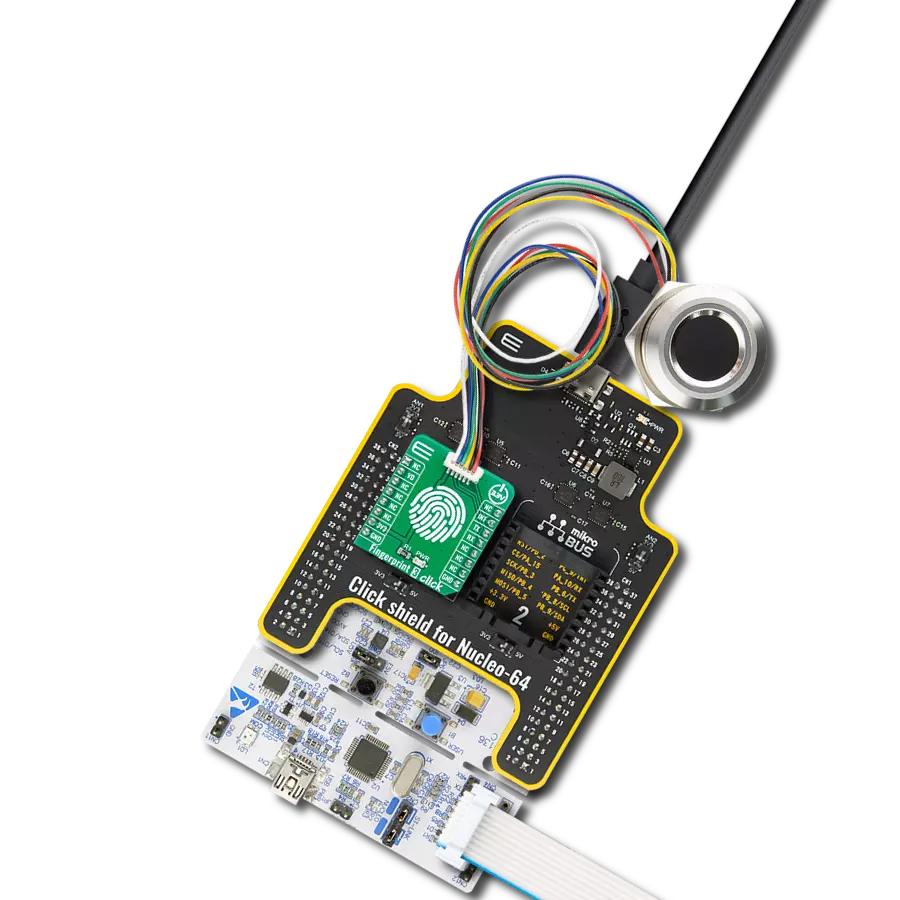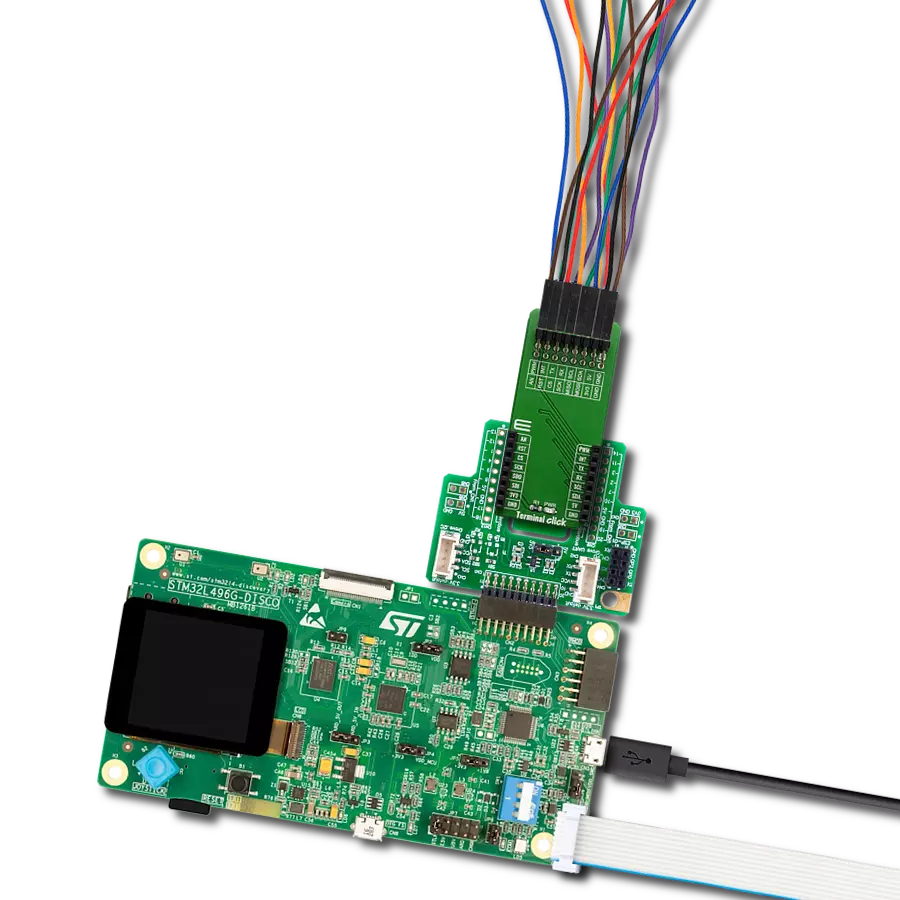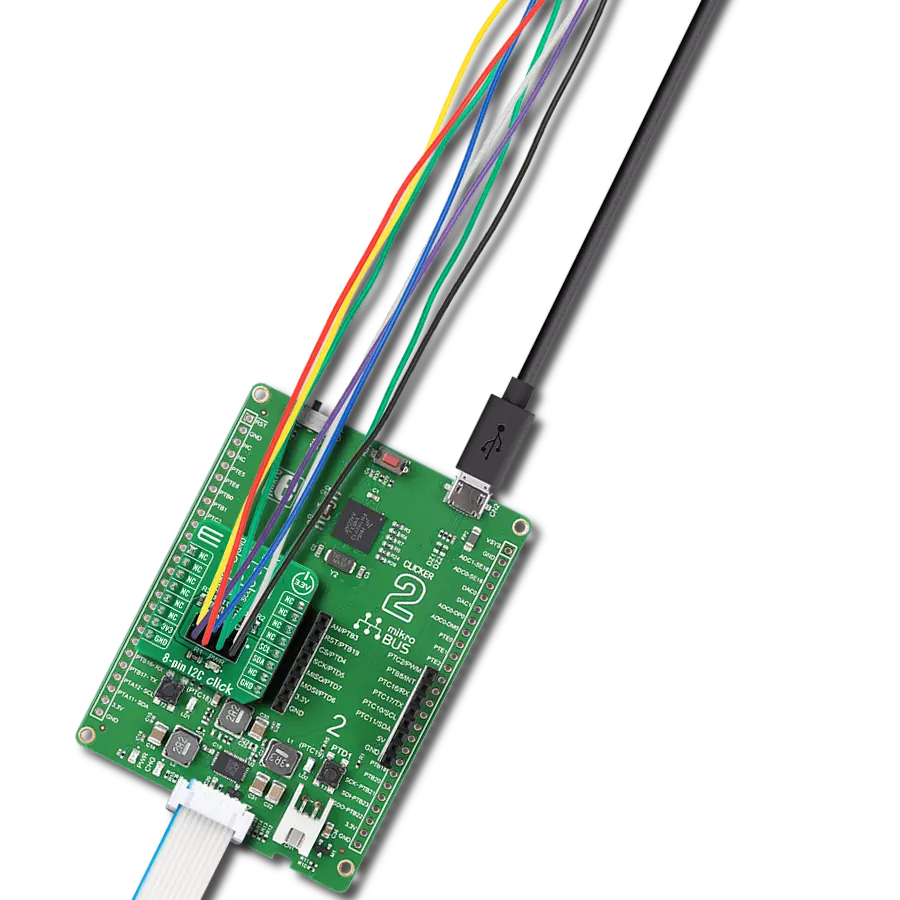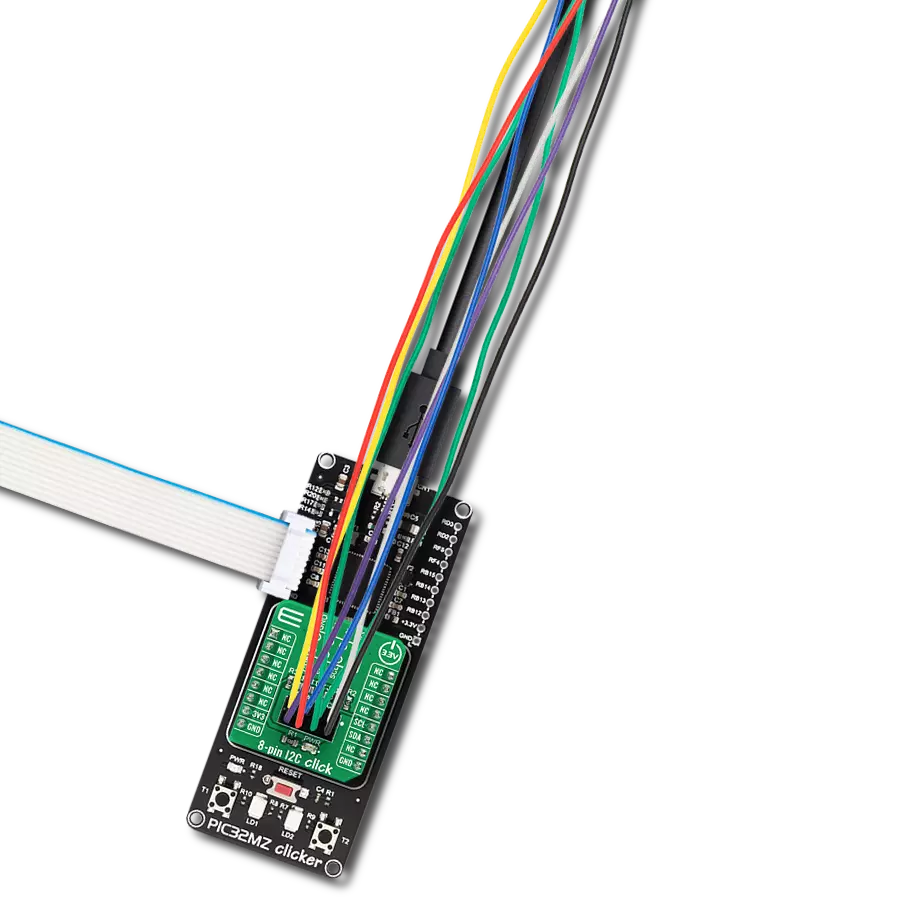Create an efficient access control application that will include an authentication solution
A
A
Hardware Overview
How does it work?
Fingerprint 3 Click is an adapter Click board™ that simplifies the connection of add-on boards to the mikroBUS™ socket. This Click board™ represents a small-size PCB that can be connected to the mikroBUS™ socket like any other Click board™, with a 1x6 1.0mm pitch vertical type wire to board connector placed on itself. Each of the header pins corresponds to a pin on the mikroBUS™ socket being used, such as UART lines (TX, RX), 3V3 power supply, finger detection signal, and Ring LED enable for GROW R503 module and ground. This Click board™ allows easy pin access and manipulation while always retaining a perfect connection quality. Fingerprint processing includes two parts: fingerprint recording and fingerprint matching. The first step is initializing all the necessary drivers, peripherals, and pins. At power-on, it takes about 200ms for initialization; during this period, the module can't accept any commands.
This is followed by checking the sensor and verifying the module password, after which a new fingerprint pattern begins if everything is done correctly. The user needs to enter the finger two times. The system will process the two-time finger images, generate a template of the finger based on processing results, and store the template. When matching, a user enters the finger through an optical sensor, and the system will generate a template of the finger and compare it with templates of the finger library. In both circumstances, the system will return the matching result, success or failure. This can also be seen in an example code that contains easy-to-use functions that may be used as a reference for further development. The Fingerprint 3 Click communicates with MCU using the UART interface with the default baud rate of 57600bps for the data transfer, while the GPIO pins on this Click board™ are used for finger detection and ring indicator LED
enable. Ring indicator LED light labeled as VD can be enabled by toggling the signal routed to the RST pin on the mikroBUS™, while the signal routed to the INT pin on the mikroBUS™ represents an interrupt and indicates the detection of a finger on the module. When the indicator glows purple, the module is in its Stand-By mode and waits for a finger to be pressed. In addition to purple, the module can also glow blue or red, indicating the fingerprint match's correctness (blue indicates that a pair is found, while red indicates that a pair was not found). This Click board™ can only be operated with a 3.3V logic voltage level. The board must perform appropriate logic voltage level conversion before using MCUs with different logic levels. However, the Click board™ comes equipped with a library containing functions and an example code that can be used as a reference for further development.
Features overview
Development board
Nucleo-64 with STM32F091RC MCU offers a cost-effective and adaptable platform for developers to explore new ideas and prototype their designs. This board harnesses the versatility of the STM32 microcontroller, enabling users to select the optimal balance of performance and power consumption for their projects. It accommodates the STM32 microcontroller in the LQFP64 package and includes essential components such as a user LED, which doubles as an ARDUINO® signal, alongside user and reset push-buttons, and a 32.768kHz crystal oscillator for precise timing operations. Designed with expansion and flexibility in mind, the Nucleo-64 board features an ARDUINO® Uno V3 expansion connector and ST morpho extension pin
headers, granting complete access to the STM32's I/Os for comprehensive project integration. Power supply options are adaptable, supporting ST-LINK USB VBUS or external power sources, ensuring adaptability in various development environments. The board also has an on-board ST-LINK debugger/programmer with USB re-enumeration capability, simplifying the programming and debugging process. Moreover, the board is designed to simplify advanced development with its external SMPS for efficient Vcore logic supply, support for USB Device full speed or USB SNK/UFP full speed, and built-in cryptographic features, enhancing both the power efficiency and security of projects. Additional connectivity is
provided through dedicated connectors for external SMPS experimentation, a USB connector for the ST-LINK, and a MIPI® debug connector, expanding the possibilities for hardware interfacing and experimentation. Developers will find extensive support through comprehensive free software libraries and examples, courtesy of the STM32Cube MCU Package. This, combined with compatibility with a wide array of Integrated Development Environments (IDEs), including IAR Embedded Workbench®, MDK-ARM, and STM32CubeIDE, ensures a smooth and efficient development experience, allowing users to fully leverage the capabilities of the Nucleo-64 board in their projects.
Microcontroller Overview
MCU Card / MCU
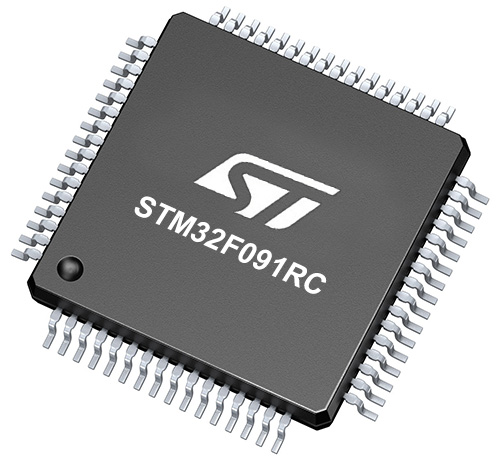
Architecture
ARM Cortex-M0
MCU Memory (KB)
256
Silicon Vendor
STMicroelectronics
Pin count
64
RAM (Bytes)
32768
You complete me!
Accessories
Click Shield for Nucleo-64 comes equipped with two proprietary mikroBUS™ sockets, allowing all the Click board™ devices to be interfaced with the STM32 Nucleo-64 board with no effort. This way, Mikroe allows its users to add any functionality from our ever-growing range of Click boards™, such as WiFi, GSM, GPS, Bluetooth, ZigBee, environmental sensors, LEDs, speech recognition, motor control, movement sensors, and many more. More than 1537 Click boards™, which can be stacked and integrated, are at your disposal. The STM32 Nucleo-64 boards are based on the microcontrollers in 64-pin packages, a 32-bit MCU with an ARM Cortex M4 processor operating at 84MHz, 512Kb Flash, and 96KB SRAM, divided into two regions where the top section represents the ST-Link/V2 debugger and programmer while the bottom section of the board is an actual development board. These boards are controlled and powered conveniently through a USB connection to program and efficiently debug the Nucleo-64 board out of the box, with an additional USB cable connected to the USB mini port on the board. Most of the STM32 microcontroller pins are brought to the IO pins on the left and right edge of the board, which are then connected to two existing mikroBUS™ sockets. This Click Shield also has several switches that perform functions such as selecting the logic levels of analog signals on mikroBUS™ sockets and selecting logic voltage levels of the mikroBUS™ sockets themselves. Besides, the user is offered the possibility of using any Click board™ with the help of existing bidirectional level-shifting voltage translators, regardless of whether the Click board™ operates at a 3.3V or 5V logic voltage level. Once you connect the STM32 Nucleo-64 board with our Click Shield for Nucleo-64, you can access hundreds of Click boards™, working with 3.3V or 5V logic voltage levels.
Fingerprint Sensor with Two-Color LED Ring (GROW R503) is a capacitive fingerprint sensor module scanner with a two-color ring indicator. The module is designed in a circular shape with a diameter of 28mm. It's important to mention that this module represents an integrated image-collecting and algorithm chip together. GROW R503 module has an image buffer and six feature file buffers. An important note for users is that all buffer contents are not saved after power failure. A fingerprint pattern template can be composed of 2-6 feature files. If the composite template has more characteristic files, the fingerprint pattern template has better quality. The module's enclosure is dust resistant but not waterproof with a ring indicator LED light controlled by command, and it has a high recognition rate and the flexibility to adapt to different conditions of human fingers, whether it's dry, wet, or a person of different ages. This module can be connected to the Fingerprint 3 Click or to any other product that has a 1.0mm pitch vertical type wire-to-board connector as this module and the appropriate type of communication.
Used MCU Pins
mikroBUS™ mapper
Take a closer look
Click board™ Schematic

Step by step
Project assembly
Software Support
Library Description
This library contains API for Fingerprint 3 Click driver.
Key functions:
void fingerprint3_parser_rsp ( fingerprint3_rsp_t *response )- Response parser function.uint8_t fingerprint3_byte_ready ( void )- Check for new byte received.void fingerprint3_uart_write ( uint8_t *tx_data, uint8_t n_bytes )- Uart write function.
Open Source
Code example
The complete application code and a ready-to-use project are available through the NECTO Studio Package Manager for direct installation in the NECTO Studio. The application code can also be found on the MIKROE GitHub account.
/*!
* \file
* \brief Fingerprint 3 Click example
*
* # Description
* This example reads and processes data from Fingerprint 3 Clicks.
*
* The demo application is composed of two sections :
*
* ## Application Init
* Initializes the driver, configures the sensor, and enrolls fingerprints.
*
* ## Application Task
* Takes an image of the finger, then checks if there's a fingerprint in the library that matches the
* one it has just read. All data is being logged on the USB UART.
*
* ## Additional Function
* - static void display_error ( uint8_t *message )
* - static void display_full_rsp ( fingerprint3_t *ctx )
* - static void search_finger( fingerprint3_t *ctx )
* - static void match_finger( fingerprint3_t *ctx, uint16_t location )
* - static uint8_t enroll_finger( fingerprint3_t *ctx, uint16_t location, uint8_t features )
*
* \author MikroE Team
*
*/
// ------------------------------------------------------------------- INCLUDES
#include "board.h"
#include "log.h"
#include "fingerprint3.h"
#include "string.h"
// ------------------------------------------------------------------ VARIABLES
#define LOCATION_IN_LIBRARY 1 // Location in flash where the fingerprint template will be stored.
#define NUMBER_OF_FINGERPRINTS 2 // Number of fingerprints for enrolling.
#define NUMBER_OF_IMAGES 3 // Number of images it will take for a single fingerprint template.
static fingerprint3_t fingerprint3;
static log_t logger;
uint8_t package_content[ FINGERPRINT3_MAX_PACKAGE_LENGTH ];
uint8_t error_check = 0;
// ------------------------------------------------------- ADDITIONAL FUNCTIONS
/**
* @brief Display error function.
*
* @param message Input string.
*
* @details This function concatenates status of response to the input string and prints it on the USB UART.
*/
static void display_error ( uint8_t *message );
/**
* @brief Display full response function.
*
* @param ctx Click object.
*
* @details This function parses and displays full response to the previously sent command on the USB UART.
*/
static void display_full_rsp ( fingerprint3_t *ctx );
/**
* @brief Search finger function.
*
* @param ctx Click object.
*
* @details This function searches the whole finger library for the template that matches the one
* it stores in char_buffer 1. All data is being logged on the USB UART.
*/
static void search_finger( fingerprint3_t *ctx );
/**
* @brief Match finger function.
*
* @param ctx Click object.
* @param location Location in library.
*
* @details This function checks if the template stored at the desired location matches the fingerprint
* it reads. All data is being logged on the USB UART.
*/
static void match_finger( fingerprint3_t *ctx, uint16_t location );
/**
* @brief Enroll finger function.
*
* @param ctx Click object.
* @param location Location in library where the fingerprint template will be stored.
* @param features Number of fingerprint images it will combine in a template.
*
* @details This function enrolls the fingerprint, creates a template combining the taken images and
* stores it at the desired location. All data is being logged on the USB UART.
*/
static uint8_t enroll_finger( fingerprint3_t *ctx, uint16_t location, uint8_t features );
// ------------------------------------------------------ APPLICATION FUNCTIONS
void application_init ( void )
{
log_cfg_t log_cfg;
fingerprint3_cfg_t cfg;
/**
* Logger initialization.
* Default baud rate: 115200
* Default log level: LOG_LEVEL_DEBUG
* @note If USB_UART_RX and USB_UART_TX
* are defined as HAL_PIN_NC, you will
* need to define them manually for log to work.
* See @b LOG_MAP_USB_UART macro definition for detailed explanation.
*/
LOG_MAP_USB_UART( log_cfg );
log_init( &logger, &log_cfg );
log_info( &logger, "---- Application Init ----" );
Delay_ms ( 100 );
// Click initialization.
fingerprint3_cfg_setup( &cfg );
FINGERPRINT3_MAP_MIKROBUS( cfg, MIKROBUS_1 );
err_t init_flag = fingerprint3_init( &fingerprint3, &cfg );
if ( init_flag == UART_ERROR )
{
log_error( &logger, " Application Init Error. " );
log_info( &logger, " Please, run program again... " );
for ( ; ; );
}
Delay_ms ( 100 );
error_check = fingerprint3_set_config ( &fingerprint3, FINGERPRINT3_DEFAULT_ADDRESS,
FINGERPRINT3_DEFAULT_PASSWORD );
display_error( "Set Config" );
Delay_ms ( 500 );
error_check = fingerprint3_soft_reset ( &fingerprint3 );
display_error( "Soft Reset" );
Delay_ms ( 500 );
error_check = fingerprint3_check_sensor ( &fingerprint3 );
display_error( "Check Sensor" );
Delay_ms ( 500 );
error_check = fingerprint3_empty_library ( &fingerprint3 );
display_error( "Empty the Library" );
Delay_ms ( 500 );
uint8_t cnt = 0;
do
{
log_printf( &logger, " >>> Register fingerprint %u of %u <<<\r\n", ( uint16_t ) cnt + 1,
( uint16_t ) NUMBER_OF_FINGERPRINTS );
log_printf( &logger, "--------------------------------- \r\n" );
error_check = enroll_finger ( &fingerprint3, LOCATION_IN_LIBRARY + cnt, NUMBER_OF_IMAGES );
display_error( "Enroll finger" );
if ( FINGERPRINT3_OK != error_check )
{
log_printf( &logger, " Please enroll your fingerprint again.\r\n" );
log_printf( &logger, "--------------------------------- \r\n" );
}
else
{
cnt++;
}
Delay_ms ( 1000 );
}
while ( FINGERPRINT3_OK != error_check || cnt != NUMBER_OF_FINGERPRINTS );
}
void application_task ( void )
{
search_finger( &fingerprint3 );
}
int main ( void )
{
/* Do not remove this line or clock might not be set correctly. */
#ifdef PREINIT_SUPPORTED
preinit();
#endif
application_init( );
for ( ; ; )
{
application_task( );
}
return 0;
}
static void display_error ( uint8_t *message )
{
log_printf( &logger, " %s: ", message );
if ( FINGERPRINT3_OK == error_check )
{
log_printf( &logger, "DONE!\r\n" );
}
else
{
log_printf( &logger, "FAIL! [ERROR] Num: 0x%.2X\r\n", ( uint16_t ) error_check );
}
log_printf( &logger, "--------------------------------- \r\n" );
}
static void display_full_rsp ( fingerprint3_t *ctx )
{
log_printf( &logger, "* Header : 0x%.4X\r\n", ctx->rsp.header );
log_printf( &logger, "* Address : 0x%.8LX\r\n", ctx->rsp.addr );
log_printf( &logger, "* Package identifier: 0x%.2X\r\n", ( uint16_t ) ctx->rsp.pkg_id );
log_printf( &logger, "* Package length : 0x%.4X\r\n", ctx->rsp.pkg_len );
log_printf( &logger, "* Confirmation code :" );
if ( ctx->rsp.pkg_content[ 0 ] == FINGERPRINT3_CONF_CMD_OK )
{
log_printf( &logger, " OK!\r\n" );
}
else
{
log_error( &logger, " Num: 0x%.2X", ( uint16_t ) ctx->rsp.pkg_content[ 0 ] );
}
if ( ctx->rsp.pkg_len > 3 )
{
log_printf( &logger, "* Package Content: " );
for ( uint16_t n_cnt = 1; n_cnt < ctx->rsp.pkg_len - 2; n_cnt++ )
{
log_printf( &logger, "0x%.2X ", ( uint16_t ) ctx->rsp.pkg_content[ n_cnt ] );
}
log_printf( &logger, "\r\n" );
}
log_printf( &logger, "* Checksum : 0x%.4X \r\n", ctx->rsp.checksum );
}
static void search_finger( fingerprint3_t *ctx )
{
log_printf( &logger, " >>> Searching Fingerprints <<< \r\n" );
log_printf( &logger, "--------------------------------- \r\n" );
fingerprint3_aura_control ( &fingerprint3, FINGERPRINT3_AURA_CTRL_BREATH, 0xFF,
FINGERPRINT3_AURA_LED_PURPLE, FINGERPRINT3_AURA_TIME_INFINITE );
log_printf( &logger, " Put your finger on the sensor \r\n" );
log_printf( &logger, "--------------------------------- \r\n" );
while ( fingerprint3_finger_indicator( &fingerprint3 ) == FINGERPRINT3_DETECT_NO_FINGER );
while ( FINGERPRINT3_OK != fingerprint3_aura_control ( &fingerprint3, FINGERPRINT3_AURA_CTRL_OFF, 0xFF,
FINGERPRINT3_AURA_LED_PURPLE,
FINGERPRINT3_AURA_TIME_INFINITE ) )
{
Delay_ms ( 100 );
}
for ( ; ; )
{
error_check = fingerprint3_take_image ( &fingerprint3 );
if ( FINGERPRINT3_OK != error_check )
{
display_error( "Take Image" );
Delay_ms ( 1000 );
continue;
}
error_check = fingerprint3_extract_features ( &fingerprint3, 1 );
if ( FINGERPRINT3_OK != error_check )
{
display_error( "Extract Features" );
Delay_ms ( 1000 );
continue;
}
break;
}
uint16_t match_score, location;
error_check = fingerprint3_search_finger ( &fingerprint3, 1, &location, &match_score );
if ( FINGERPRINT3_OK == error_check )
{
log_printf( &logger, " >>>>> FINGERPRINT MATCH <<<<<< \r\n\r\n" );
log_printf( &logger, " Location: 0x%.4X Match score : %u\r\n", location, match_score );
log_printf( &logger, "---------------------------------\r\n" );
fingerprint3_aura_control ( &fingerprint3, FINGERPRINT3_AURA_CTRL_BREATH, 0x80,
FINGERPRINT3_AURA_LED_BLUE, 1 );
}
else if ( FINGERPRINT3_CONF_NOT_FOUND == error_check )
{
log_printf( &logger, " >>>>> NO MATCH in library <<<<<<\r\n\r\n" );
log_printf( &logger, "---------------------------------\r\n" );
fingerprint3_aura_control ( &fingerprint3, FINGERPRINT3_AURA_CTRL_BREATH, 0x80,
FINGERPRINT3_AURA_LED_RED, 1 );
}
else
{
display_error( "Search Finger" );
fingerprint3_aura_control ( &fingerprint3, FINGERPRINT3_AURA_CTRL_BREATH, 0x80,
FINGERPRINT3_AURA_LED_RED, 1 );
}
Delay_ms ( 100 );
log_printf( &logger, " Lift the finger of the sensor.\r\n" );
log_printf( &logger, "--------------------------------- \r\n" );
error_check = fingerprint3_take_image ( &fingerprint3 );
while ( error_check != FINGERPRINT3_CONF_NO_FINGER )
{
Delay_ms ( 100 );
error_check = fingerprint3_take_image ( &fingerprint3 );
}
while ( fingerprint3_finger_indicator( &fingerprint3 ) != FINGERPRINT3_DETECT_NO_FINGER );
Delay_ms ( 1000 );
}
static void match_finger( fingerprint3_t *ctx, uint16_t location )
{
error_check = fingerprint3_load_template ( &fingerprint3, 2, location );
display_error( "Load Template" );
Delay_ms ( 100 );
log_printf( &logger, " >>> Matching Fingerprints <<< \r\n" );
log_printf( &logger, "--------------------------------- \r\n" );
fingerprint3_aura_control ( &fingerprint3, FINGERPRINT3_AURA_CTRL_BREATH, 0xFF,
FINGERPRINT3_AURA_LED_PURPLE, FINGERPRINT3_AURA_TIME_INFINITE );
log_printf( &logger, " Put your finger on the sensor \r\n" );
log_printf( &logger, "--------------------------------- \r\n" );
while ( fingerprint3_finger_indicator( &fingerprint3 ) == FINGERPRINT3_DETECT_NO_FINGER );
while ( FINGERPRINT3_OK != fingerprint3_aura_control ( &fingerprint3, FINGERPRINT3_AURA_CTRL_OFF, 0xFF,
FINGERPRINT3_AURA_LED_PURPLE,
FINGERPRINT3_AURA_TIME_INFINITE ) )
{
Delay_ms ( 100 );
}
for ( ; ; )
{
error_check = fingerprint3_take_image ( &fingerprint3 );
if ( FINGERPRINT3_OK != error_check )
{
display_error( "Take Image" );
Delay_ms ( 1000 );
continue;
}
error_check = fingerprint3_extract_features ( &fingerprint3, 3 );
if ( FINGERPRINT3_OK != error_check )
{
display_error( "Extract Features" );
Delay_ms ( 1000 );
continue;
}
break;
}
uint16_t match_score;
error_check = fingerprint3_match_finger ( &fingerprint3, &match_score );
if ( FINGERPRINT3_OK == error_check )
{
log_printf( &logger, " >>>>> FINGERPRINT MATCH <<<<<< \r\n\r\n" );
log_printf( &logger, " Match score : %u\r\n", match_score );
log_printf( &logger, "---------------------------------\r\n" );
fingerprint3_aura_control ( &fingerprint3, FINGERPRINT3_AURA_CTRL_BREATH, 0x80,
FINGERPRINT3_AURA_LED_BLUE, 1 );
}
else if ( FINGERPRINT3_CONF_NO_MATCH == error_check )
{
log_printf( &logger, " >>>>> NO MATCH at location: 0x%.4X <<<<<<\r\n\r\n", location );
log_printf( &logger, "---------------------------------\r\n" );
fingerprint3_aura_control ( &fingerprint3, FINGERPRINT3_AURA_CTRL_BREATH, 0x80,
FINGERPRINT3_AURA_LED_RED, 1 );
}
else
{
display_error( "Match Finger" );
fingerprint3_aura_control ( &fingerprint3, FINGERPRINT3_AURA_CTRL_BREATH, 0x80,
FINGERPRINT3_AURA_LED_RED, 1 );
}
Delay_ms ( 100 );
log_printf( &logger, " Lift the finger of the sensor.\r\n" );
log_printf( &logger, "--------------------------------- \r\n" );
error_check = fingerprint3_take_image ( &fingerprint3 );
while ( error_check != FINGERPRINT3_CONF_NO_FINGER )
{
Delay_ms ( 100 );
error_check = fingerprint3_take_image ( &fingerprint3 );
}
while ( fingerprint3_finger_indicator( &fingerprint3 ) != FINGERPRINT3_DETECT_NO_FINGER );
Delay_ms ( 1000 );
}
static uint8_t enroll_finger( fingerprint3_t *ctx, uint16_t location, uint8_t features )
{
for ( uint8_t cnt = 1; cnt <= features; )
{
log_printf( &logger, " >>> Taking image %u of %u <<<\r\n", ( uint16_t ) cnt,
( uint16_t ) features );
log_printf( &logger, "--------------------------------- \r\n" );
log_printf( &logger, " Put your finger on the sensor \r\n" );
log_printf( &logger, "--------------------------------- \r\n" );
fingerprint3_aura_control ( &fingerprint3, FINGERPRINT3_AURA_CTRL_BREATH, 0xFF,
FINGERPRINT3_AURA_LED_PURPLE, FINGERPRINT3_AURA_TIME_INFINITE );
while ( fingerprint3_finger_indicator( &fingerprint3 ) == FINGERPRINT3_DETECT_NO_FINGER );
while ( FINGERPRINT3_OK != fingerprint3_aura_control ( &fingerprint3, FINGERPRINT3_AURA_CTRL_OFF, 0xFF,
FINGERPRINT3_AURA_LED_PURPLE,
FINGERPRINT3_AURA_TIME_INFINITE ) )
{
Delay_ms ( 100 );
}
error_check = fingerprint3_take_image ( &fingerprint3 );
display_error( "Take Image" );
if ( FINGERPRINT3_OK == error_check )
{
Delay_ms ( 100 );
error_check = fingerprint3_extract_features ( &fingerprint3, cnt );
display_error( "Extract Features" );
if ( FINGERPRINT3_OK == error_check )
{
cnt++;
}
Delay_ms ( 100 );
fingerprint3_aura_control ( &fingerprint3, FINGERPRINT3_AURA_CTRL_BREATH, 0x80,
FINGERPRINT3_AURA_LED_BLUE, 1 );
Delay_ms ( 100 );
}
log_printf( &logger, " Lift the finger of the sensor.\r\n" );
log_printf( &logger, "--------------------------------- \r\n" );
error_check = fingerprint3_take_image ( &fingerprint3 );
while ( error_check != FINGERPRINT3_CONF_NO_FINGER )
{
Delay_ms ( 100 );
error_check = fingerprint3_take_image ( &fingerprint3 );
}
while ( fingerprint3_finger_indicator( &fingerprint3 ) != FINGERPRINT3_DETECT_NO_FINGER );
Delay_ms ( 100 );
}
error_check = fingerprint3_create_template ( &fingerprint3 );
display_error( "Create Template" );
if ( FINGERPRINT3_OK != error_check )
{
return error_check;
}
Delay_ms ( 100 );
error_check = fingerprint3_store_template ( &fingerprint3, 1, location );
display_error( "Store Template" );
if ( FINGERPRINT3_OK != error_check )
{
return error_check;
}
Delay_ms ( 100 );
return FINGERPRINT3_OK;
}
// ------------------------------------------------------------------------ END
Additional Support
Resources
Category:Adapter
